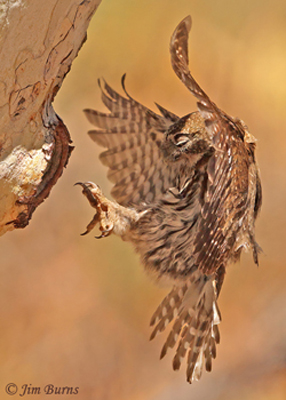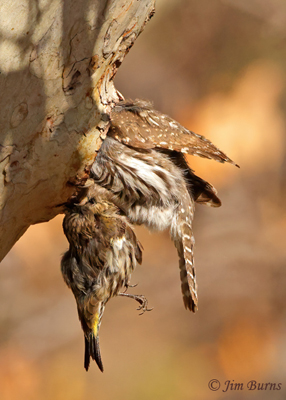
Or perhaps not. I shall see. It was one year ago last week that I was set up, with tripod and telephoto lens on the roadbed, eye level to the Northern Pygmy-Owl nest cavity in the Sycamore grove below. First one there as usual, and masked, I watched with growing consternation as my fellow birders trickled in, unmasked, and stood in clots and clusters behind me, craning and straining to see the exact spot on which I was focused through the canopy of limbs and leaves.
Finally an unmasked, middle-aged woman with binoculars walked up, tapped me on the shoulder, and asked if she could look through my camera viewfinder to see the hole in the Sycamore from which the owls were coming and going. I recoiled, asked her what rock she had been living under, and told her to back off and get away from me. After that exchange, I hadn’t stayed too much longer because of the clueless, cautionless crowd that was gathering, but also because the only good viewing angle for this nest was looking straight into the cavity.
Now, a year later, despite Mark Stevenson’s best efforts to keep owl locations off the AZ/NM listserv, word has filtered through the birding community that the pygmy-owls are nesting again in a different but nearby Sycamore. I breakfast quickly, hurry up canyon to the general area, masked and cautious, almost as curious about the birders’ behavior as I am about that of the owls. The cavity tree proves easy to find as there are several people already there, mostly maskless, some standing, some sitting on rocks waiting.
Northern Pygmy-Owls are a fascinating species, the size of a sparrow, that tiny size belying their well-deserved reputation for the ferocity with which they will attack and take prey twice their seven inch length. Solitary outside of nesting season, pygmies in Arizona are more secretive and far less common than our Elf Owls and screech-owls, and may patrol territories up to a square mile in area. Little wonder then that a known nest cavity attracts serious birders. And bird photographers.
And despite this year’s nest Sycamore being in a much more open and accessible area, and much lower than the previous year’s nest, all the arriving birders cluster together in the same spot, one that allows them to look and shoot (I see way more cameras than masks) straight into the cavity. I am delighted at this, and I chuckle to myself as I hurry to set up at 90% to the line of sight into the hole, well away from this throng. I stay masked up just in case some fool walks over like last year to chat me up.
Northern Pygmy-Owls are, of course, diurnal, but even with young in the nest they do not hunt at first light but wait until the sun has warmed up the bugs, which in turn attract the birds and small mammals which comprise 90% of the owls’ diet, and the lizards which are their favored Arizona desert prey. My prayer for this trip has been to get back into my “office,” the outdoors, and catch a parent owl on its way into or out of the nest hole, with or without prey, a catch not possible from the angle where all the other camera bearers are congregated.
As you can see from the three images accompanying this column, my prayer is answered. Eventually. It takes an entire morning of vigilance, but I am able to avoid standing shoulder to shoulder in a crowd of mostly maskless photographers jockeying to shoot straight up through limbs and leaves when the parent owls stage in the canopy with prey. And from where the birders are clustered, when prey is delivered all they see or shoot will be the owls’ backside obscuring the cavity itself.
Northern Pygmy-Owl is Glaucidium gnoma. The species name gnoma, comes to us from the Greek verb gnome—to know—and is associated in Greek mythology with Athena, the goddess of wisdom. Springtime in my outdoor office is good, especially this long anticipated spring, but my morning with these owls reinforces my thought that our avian fellow travelers possess much more wisdom about survival and success in our world than my own species does. We have much to learn in our obliviousness to the natural world which surrounds us.
Northern Pygmy-Owl with Pine Siskin for nestlings# 2--4670 |
Northern Pygmy-Owl with Pine Siskin for nestlings--4667 |

